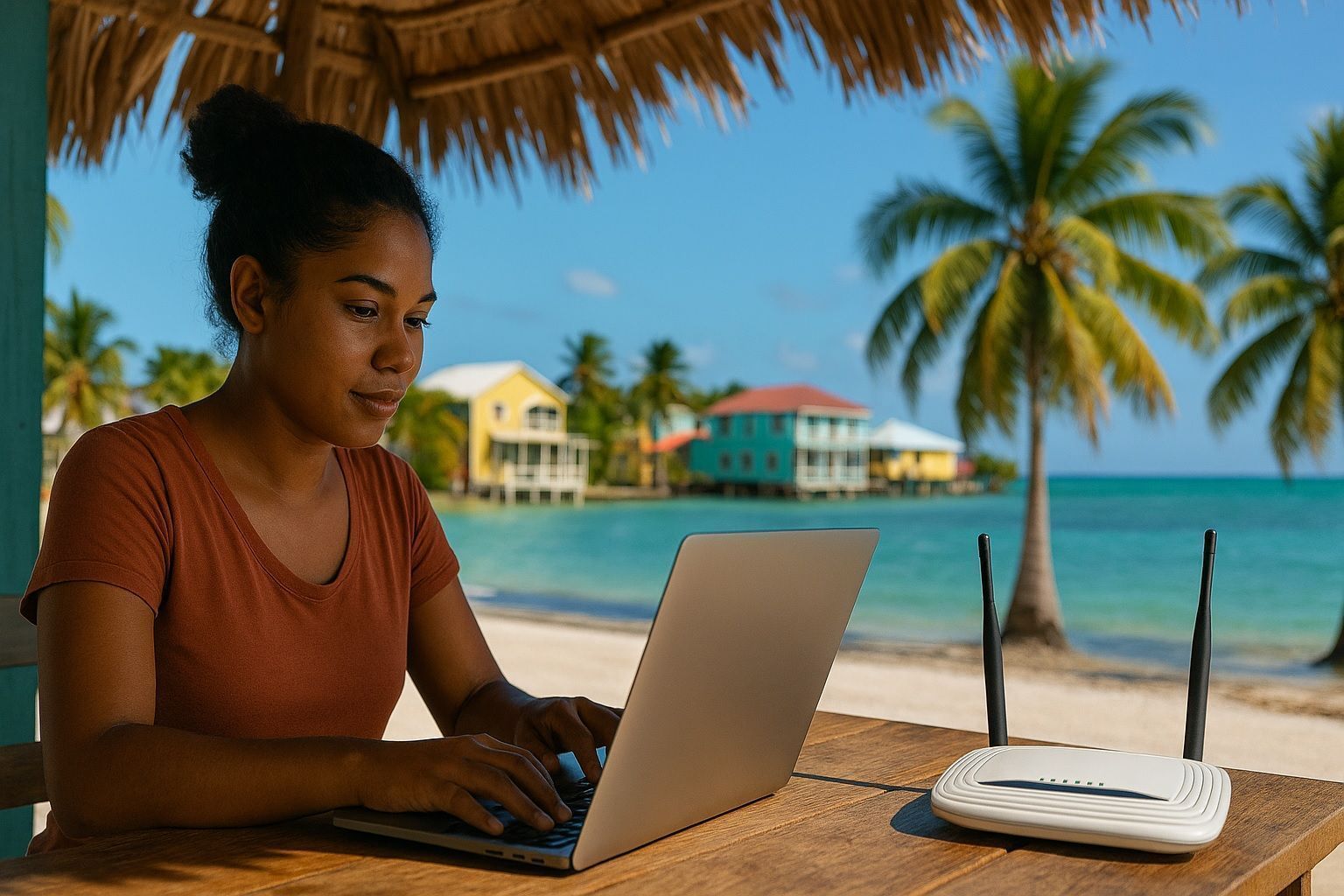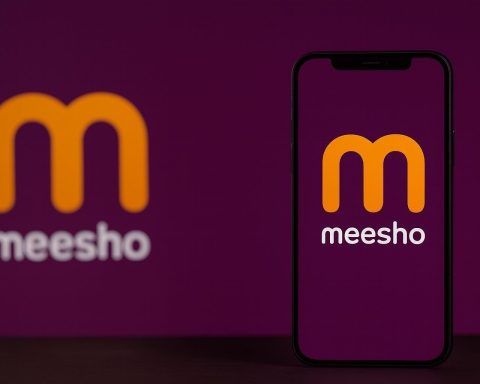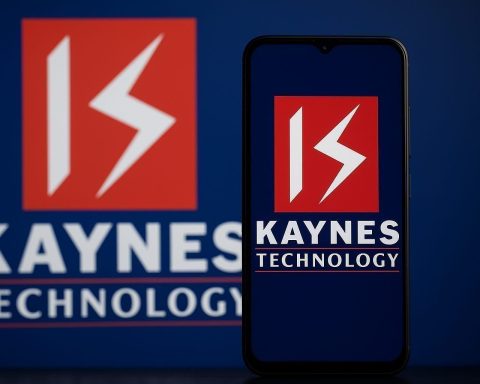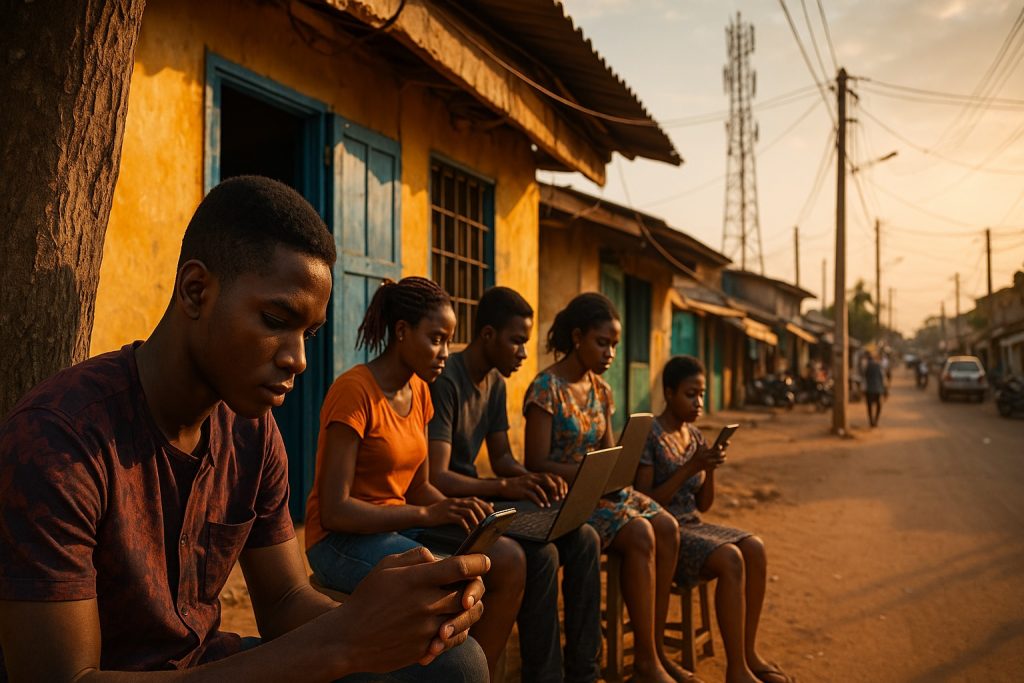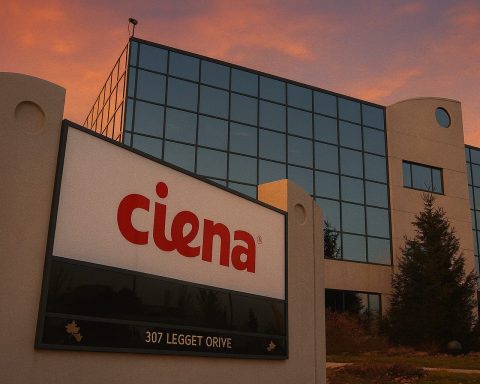- Belize had about 304,000 online residents in 2025, representing 72.4% of the population.
- There were 345,000 active mobile connections in early 2025, about 82% of the population, with many users owning multiple SIMs.
- Approximately 84.5% of mobile subscriptions are broadband (3G/4G/LTE capable).
- In urban Belize, the median home broadband speed reached about 48 Mbps as of January 2025, up roughly 8% from the prior year.
- About 47% of the population lives in urban areas, while 53% is rural, with rural regions still lagging in high-speed access.
- Digi (BTL) provides a nationwide fiber-to-the-home network with speeds from 20 Mbps to 150 Mbps (200 Mbps on premium plans) and launched the DigiOne quad-play in 2023.
- Smart (Speednet) offers 4G/3G wireless and fixed wireless like “Smart Broadband Unlimited,” with unmetered data and speeds of a few Mbps at lower prices, serving over 100,000 mobile customers.
- Local cable ISPs such as Centaur Cable deliver regional broadband (10–50 Mbps), with Centaur serving Orange Walk and Corozal and prices starting around BZ$49 for 20 Mbps.
- Satellite options include Viasat (since 2021) at about 17 Mbps down / 3 Mbps up with a 1000 GB monthly cap, and Starlink (2022–2023) but as of January 2025 the PUC denied a full nationwide license, allowing only limited use in unserved areas or on vessels/aircraft with terminal registration required.
- Phase 1 of Belize’s Digital Connect Centers was completed in August 2024, establishing 14 community hubs nationwide to provide free high-speed internet and digital-skills training.
Belize is experiencing a noteworthy digital transformation as of 2025. Internet usage has grown rapidly – about 304,000 people are online, representing 72.4% of the population [1] [2]. This is a dramatic rise from a decade ago, though it still means roughly 27.6% of Belizeans remain offline [3]. Mobile connectivity is widespread: there were 345,000 active mobile connections in early 2025, which is about 82% of the population (many people use more than one SIM) [4]. Importantly, 84.5% of these mobile subscriptions are “broadband” (3G/4G/LTE capable) [5], indicating that the vast majority of cell phone users have access to mobile data networks.
Urban areas enjoy the lion’s share of high-speed access. Roughly 47% of Belize’s population lives in urban centers [6] (Belize City, Belmopan, San Pedro, etc.), and these areas are now served by modern fiber-optic broadband and robust 4G cellular coverage. In these cities and towns, fixed broadband speeds have improved markedly – the typical home internet connection reached a median download speed of about 48 Mbps as of January 2025 [7] [8], a notable jump of ~8% over the previous year as networks upgraded. By contrast, rural communities – which make up 53% of the population [9] – often lag behind. Many remote villages and islands historically had to rely on older technologies or even satellite links for internet [10]. While the ongoing fiber rollout is bringing broadband to more rural towns, gaps persist in sparsely populated or difficult-to-reach areas, where connectivity can still be slow or unavailable. In short, Belize’s digital divide is narrowing but not yet closed: most Belizeans now have internet access, and speeds are improving, but a significant minority (especially in remote rural areas) remain underserved by modern broadband.
Major ISPs: Who’s Connecting Belize
Internet services in Belize are provided by a handful of key players. The market is dominated by Belize Telemedia Limited (BTL) – the state-owned telecom company that operates under the brand “Digi” – alongside a smaller competitor, Speednet Communications, which operates the “Smart” brand. In addition, several local cable companies offer broadband in particular regions. The table below compares the major ISPs and their offerings:
| Provider | Network & Coverage | Services & Speeds | Indicative Pricing (BZ$) |
|---|---|---|---|
| Digi (BTL) – Belize Telemedia Ltd. State-owned incumbent | Nationwide fiber-optic broadband network (FTTH) and mobile network. ~90% of homes have fiber access after massive rollout [11]; mobile network (2G/3G/4G) covers virtually all populated areas. | Home Internet: Fiber plans from 20 Mbps up to 150 Mbps (or 200 Mbps on premium plans) [12] [13]; symmetric or high download speeds with fiber-to-the-home. Mobile: 3G/4G LTE data, voice, SMS services nationwide. | Fiber Broadband: BZ$49/month for 20 Mbps entry plan, up to BZ$199 for 150 Mbps [14]. (A premium bundle offers 200 Mbps + IPTV for BZ$219 [15].) Mobile: Various prepaid/postpaid plans; pricing is higher than Smart for similar data. |
| Smart (Speednet) Private competitor | 4G LTE and 3G wireless network covering major cities, towns, and highways (nationwide in inhabited areas). No wired infrastructure – relies on wireless delivery for both mobile and home internet. | Mobile: GSM/LTE phone service (voice, text) and data plans. Launched LTE in 2015 and now offers countrywide 4G data coverage [16]. Fixed Wireless: “Smart Broadband Unlimited” home internet via 4G networks; speeds are modest (on the order of a few Mbps) but with unlimited data for home use. | Mobile: Generally lower cost than Digi’s plans [17] (Smart markets more affordable data bundles). Broadband: For example, Smart has offered unlimited wireless home internet at BZ$55/month for ~1 Mbps service [18]. Higher-speed packages (several Mbps) are available at higher cost (still usually cheaper per month than Digi’s fiber, but also much slower). |
| Local Cable ISPs (e.g. Centaur Cable) Regional providers | Cable broadband (HFC) networks in specific locales. Coverage is limited to certain towns/regions (e.g. Centaur serves Orange Walk and Corozal districts, with expansion to other areas like Ladyville [19]). These companies often bundle TV and internet over coaxial cable. | Home Internet: Cable modem service with speeds typically ranging from 10–50 Mbps for residential plans. Some have boosted speeds in recent years (Centaur now offers up to ~50 Mbps downloads) [20]. TV: Multi-channel cable television service (often bundled with internet). | Bundled plans are common. For instance, Centaur’s residential internet starts around BZ$49/month for 20 Mbps, ~BZ$65 for 40 Mbps [21], and higher tiers (e.g. 50 Mbps) for roughly BZ$80. Bundle packages with TV (100+ channels) and internet (e.g. 30 Mbps) cost around BZ$69 per month [22]. |
Digi/BTL remains the backbone of Belize’s internet. It is the only fixed-line telephone provider and by far the largest broadband ISP [23]. After being re-nationalized by the government in 2009, BTL (branded Digi) embarked on major upgrades – replacing old copper lines with fiber and expanding 4G mobile service – which has solidified its dominance. Today Digi provides virtually all landline phones, the majority of home internet connections, and also leads in mobile subscriptions. In fact, Digi is effectively a monopoly in fixed broadband, though it faces some competition in mobile [24]. By 2022–2023, Digi’s aggressive rollout of its “DigiNet” fiber-optic service signed up over 34,000 fiber broadband customers and extended fiber coverage to 80–90% of premises nationwide [25] [26]. This has transformed internet speeds for many Belizeans, allowing the company to offer packages up to 150–200 Mbps for home users [27] [28] – a huge leap from the days of DSL. Digi also introduced quad-play bundles (Internet + IPTV + mobile + landline) to add value; for example, a BZ$219/month bundle includes 200 Mbps internet, a suite of TV channels, and phone service [29].
Smart/Speednet, the only other mobile operator, gives Belizeans an alternative, especially for mobile phone and data services. Smart entered the market in 2005 and initially built a CDMA network [30], but later transitioned to 3G UMTS and 4G LTE to stay competitive [31]. Smart prides itself on being a lower-cost choice: its voice and data plans are generally priced a bit below Digi’s, which has attracted over 100,000 customers to Smart (roughly one-third of the mobile market) [32]. For home internet, Smart does not have its own wired network, so it leverages its wireless network to offer “fixed” broadband. Customers can get a 4G LTE router or similar device and subscribe to Smart’s “Broadband Unlimited” service, which, as the name suggests, provides unmetered data. The trade-off is speed: these plans might deliver only a few Mbps (adequate for basic browsing/streaming) because they depend on cellular bandwidth. For instance, a basic Smart broadband package advertised 1 Mbps unlimited for BZ$55 [33] – useful in areas without fiber, though far slower than Digi’s offerings. Smart’s presence has forced Digi to be more competitive and innovative, but Digi still holds the upper hand in coverage (especially in rural areas) and infrastructure investments.
Beyond these two, smaller ISPs and cable companies serve niche markets. In the north, Centaur Cable Network is a notable provider: it delivers cable TV and internet in towns like Orange Walk and Corozal. Centaur and others (e.g. CBC in Belize City, Southern Cable in Stann Creek, etc.) typically offer broadband over hybrid fiber-coax networks, with speeds of 20–50 Mbps for residential users. Their pricing in Belize dollars is often comparable to Digi’s rates (sometimes a bit lower for similar speeds) [34]. These regional ISPs give consumers additional choices in their locales and help extend service into some communities not reached by BTL’s network. However, their scale is limited – none have nationwide coverage, and they collectively serve a minority of Belize’s internet subscribers. In summary, most Belizeans get internet from either Digi or Smart, with a small portion using local cable ISPs or other niche providers.
Satellite Internet: Reaching the Unconnected
Given Belize’s challenging terrain and many offshore cayes (islands), satellite internet has long played a role in connecting remote areas. In places where running fiber or even a cellular tower is impractical, satellites can beam in connectivity from the sky. As of 2025, satellite options in Belize are expanding, but also facing new regulatory scrutiny.
For years, Belizeans in rural districts or outer islands could subscribe to satellite services from providers like HughesNet or Dish Network (via local installers). These services were relatively expensive but often the only choice off the grid. A typical setup cost about US$120 per month (around BZ$240) for an “unlimited” plan delivering roughly 25 Mbps download and 2 Mbps upload speeds [35]. Equipment (a 2–6 foot satellite dish) and installation are extra, and require professional alignment to communicate with the satellite [36] [37]. Despite latency and weather-related issues, such satellite links have been lifesavers for rural homes and businesses, enabling basic broadband where no other service reaches.
In 2021, a new player entered Belize’s skies: Viasat, a satellite broadband provider with coverage across the Americas. Viasat’s service became available nationwide and offered improved performance – around 17 Mbps down / 3 Mbps up, with a generous data allowance (~1000 GB per month) [38] [39]. This high data cap effectively means most users can surf freely without hitting a limit. Viasat’s monthly fees in Belize are reportedly in the same ballpark (around US$100–$150, depending on plan) as older satellite services, making it a competitive option for remote internet. HughesNet has also continued to serve Belize via its newer satellites, but generally with lower data caps than Viasat. Overall, by early 2020s, rural customers were seeing somewhat better satellite choices than before, albeit still at prices well above typical wired internet.
The biggest buzz in satellite internet has been Starlink, Elon Musk’s constellation of low-earth-orbit satellites that promises broadband speeds of 50–150 Mbps virtually anywhere. Starlink signals began reaching Belize in 2022–2023, and tech-savvy users found that the Starlink “RV” service (a roaming satellite dish intended for travelers) could indeed connect in Belize [40]. This led to a quiet gray-market adoption – some boaters, expats, and remote lodges started using Starlink dishes by 2023, even though Starlink did not yet have official authorization to sell services in the country [41]. Many locals grew excited about Starlink’s potential to revolutionize rural connectivity with its high speeds and simpler setup.
However, regulatory hurdles emerged. In 2024, Starlink’s parent company applied to Belize’s Public Utilities Commission (PUC) for an ISP license. In January 2025, the PUC denied Starlink’s application for a full nationwide service license [42]. Instead, regulators ruled that Starlink can only be used in Belize under limited conditions: specifically, in “unserved or underserved” areas that lack any other internet service, on vessels and aircraft (in motion), or during emergencies when terrestrial networks fail】 [43]. The PUC’s decision essentially protects the domestic providers from unrestricted Starlink competition, at least for now. Officials cited the need to consider “consumer expectations, the existing regulatory framework, and the potential impact on current telecom providers” in making their decision [44]. They even mandated that any existing Starlink users must register their terminals with the government, to keep the service in check [45]. In public statements, the PUC acknowledged Starlink’s technology can be “beneficial for education, research…in unserved areas”, but made it clear that blanket deployment of Starlink in Belize was not approved [46] [47]. Essentially, Starlink in 2025 is in a legal limbo – allowed only as a last-resort solution for connectivity deserts, rather than as a mainstream ISP.
For Belizeans, this means satellite internet remains a niche (albeit crucial) service. Remote communities deep in the mainland or outer islands will continue to rely on satellites (be it Viasat, HughesNet, or case-by-case Starlink) to get online. The costs – around BZ$200–$300 per month – are steep relative to the average income, so these solutions are often used by businesses, expatriates, or as community shared connections (for example, a village satellite link feeding a local Wi-Fi hotspot). The performance gap between satellite and Belize’s terrestrial fiber network is significant: a rural family on Viasat (17 Mbps) cannot experience the same speeds that an urban family on DigiNet fiber can (100+ Mbps). Latency (signal delay) on traditional satellites is also high, making real-time apps like video calls or gaming challenging. Starlink’s low-earth orbit design greatly reduces latency and can deliver very high speeds, which is why many saw it as a game-changer. Whether Starlink eventually becomes widely authorized in Belize could have a big impact on bridging the last gaps – it’s a space to watch in coming years.
In summary, satellite internet plays the role of safety net in Belize’s internet ecosystem. It ensures that even the most isolated corner of the country can get online somehow. 2025 finds Belize at an interesting juncture: the country’s own networks have expanded so much that satellites are now a solution for relatively few users, but those users are the hardest to reach and often the most in need. The introduction of new satellite technologies (like Starlink) has the potential to further erode the urban-rural digital divide, if regulatory and market conditions allow. For now, satellites remain the connection of last resort – vital for a minority of Belizeans, but secondary to terrestrial networks for most of the population.
Recent Developments in Internet Infrastructure
The past few years have brought major improvements to Belize’s internet infrastructure, triggering the “boom” in access and speeds. Fiber-optic expansion has been the cornerstone. Belize Telemedia (Digi) invested approximately BZ$93 million since the late 2010s to extend fiber-optic cables across the country [48]. This ambitious project included running over 2,000 km of fiber and upgrading last-mile connections in every district [49]. By 2022, FTTH (fiber-to-the-home) networks passed 90% of all households in Belize [50] – an extraordinary reach for a developing nation. Many communities that previously had only old copper DSL or no wired service at all suddenly found themselves able to get gigabit-capable fiber lines. Thousands of customers migrated to fiber broadband as a result, leaving behind dial-up and DSL. This fiber rollout has not only increased speeds but also reliability (fiber is less susceptible to interference and storms than copper or microwave links). Digi reports that about 80% of residences are now within its high-speed broadband footprint [51], and it continues to fill in remaining gaps.
Upgrades weren’t limited to fixed lines. The mobile network infrastructure also saw enhancements. Digi launched LTE-Advanced (4G) services and has been steadily adding new cell sites, including in previously uncovered rural spots and tourist islands [52]. For example, new 4G towers were recently installed on small islands like Coco Plum Caye and Manta Island [53], extending coverage to popular resort areas. By 2025, Digi operates over 150 cell sites nationwide, and both Digi and Smart claim to cover essentially all inhabited areas with at least a basic mobile signal [54]. While 4G coverage is widespread, it’s noted that not everyone is on 4G yet – roughly 30% of mobile users (over 120,000 people) still rely on older 2G/3G networks or have devices that don’t support LTE [55] [56]. Nonetheless, average mobile internet speeds have improved along with coverage. (Belize’s mobile data speeds are still modest by global standards, but the ongoing upgrades aim to boost them further.)
Another significant development is the introduction of new services and packages. In a bid to increase adoption, Digi started bundling services: the “DigiOne” quad-play (one bill for internet, TV, mobile and landline) launched in 2023 [57]. The IPTV service (digital television via internet) included in these bundles is a new offering, riding on the enhanced fiber network. The existence of such bundles – and their relative affordability compared to earlier offerings – suggests a more competitive, customer-centric approach by the incumbent. In the mobile arena, both Digi and Smart began offering eSIMs (embedded SIM technology) by 2023 [58], making it easier for customers (especially tourists or dual-SIM users) to activate service without physical SIM cards. These may seem like small updates, but together they modernize Belize’s telecom services to be closer in line with global trends.
The government and international partners have also been active in improving digital infrastructure and inclusion. A notable initiative is the “Digital Connect Centers” program. By August 2024, Belize completed Phase 1 of this program, setting up 14 community internet hubs across the country [59] [60]. These centers – in towns and villages like San Ignacio, Belmopan, Ladyville, Pomona, Trial Farm and others – are equipped with computers and free high-speed internet access for the public [61] [62]. Spearheaded by the Ministry of Public Utilities & E-Governance, with support from international partners (Taiwan ICDF and UNDP), the centers aim to bridge the digital divide by giving marginalized communities a place to get online, conduct e-government transactions, and learn digital skills [63] [64]. Hundreds of youths have already undergone training (e.g. in basic Microsoft Office) at these centers [65]. This project, along with a broader National Broadband Plan in development [66], shows a strategic push to not only build infrastructure but ensure that citizens can use it. The National Broadband Plan reportedly focuses on extending fiber connectivity to remaining rural areas and establishing a local Internet Exchange Point (IXP) to keep Belize’s data traffic local and faster [67].
In terms of international connectivity, Belize is connected to global internet backbones primarily via submarine fiber optic cables and terrestrial links through Mexico/Guatemala. A few years ago, BTL completed a new submarine cable linking the mainland to Ambergris Caye (the largest island) [68]. This was a big deal for San Pedro Town on Ambergris, which previously relied on a microwave relay and often suffered slowdowns. With the submarine cable in place, Ambergris Caye now enjoys fiber service just like the mainland. There are also legacy undersea cables (such as segments of the ARCOS-1 system) landing in Belize that tie it into the regional network. While not a recent development, it’s worth noting that Belize has redundancy in international bandwidth – crucial for reliability, especially when hurricanes or accidents damage one connection. There was talk of Belize getting access to additional regional cable systems or boosting bandwidth capacity to meet growing demand, and the steady rise in average speeds suggests that international bandwidth is no longer a major bottleneck (unlike a decade ago when Belize had very limited pipes to the global internet).
Finally, the COVID-19 pandemic (2020–2022) indirectly accelerated some improvements. With lockdowns and remote schooling, there was pressure on telecom providers to improve service. Digi, for instance, launched “DigiLearn” online learning platforms and distributed tablets to students as part of an e-learning push [69]. The government invested in devices for schools (over 15,000 tablets were purchased for students) [70]. These efforts highlighted the need for better connectivity in all corners of Belize, which in turn justified the fast-tracking of broadband projects and the digital community centers. By 2025, many of those emergency measures have evolved into permanent upgrades – schools connected with fiber or wireless links, more citizens seeing internet as an essential utility, and telecom operators recognizing that demand for bandwidth will only continue to grow.
All told, Belize’s internet infrastructure in 2025 is leaps and bounds ahead of where it was just a few years prior. Fiber-optic cables span most of the country, 4G mobile is standard, and even remote villages are slowly coming online through targeted projects or satellite fallback. These developments lay a strong foundation for the future, although they also cast into relief the remaining hurdles that Belize faces in achieving universal, high-quality internet access.
Challenges in Expanding Internet Access
Despite commendable progress, Belize continues to face significant challenges in expanding and improving internet access for all its citizens. Key obstacles include:
- Geographical Hurdles: Belize’s terrain and settlement pattern make infrastructure roll-out difficult. The country has dense rainforests, mountains, and numerous small islands, with a relatively low population density outside urban areas. Building and maintaining network infrastructure in remote jungles or sparsely inhabited villages is costly and technically challenging [71]. For instance, stringing fiber or erecting cell towers in far-flung areas can be impeded by rough topography and long distances, leading to some communities still lacking coverage.
- High Costs and Affordability: Internet and cellular services in Belize have historically been among the most expensive in Central America [72]. While prices have moderated, they remain a barrier for many. Consumer incomes are modest (Belize is a lower-middle income country), so the cost of a home broadband plan or a big mobile data package can be prohibitive for low-income households. Many Belizeans still grapple with expensive data charges and monthly fees [73], forcing them to ration usage or stick to slower alternatives. Ensuring internet is affordable to the remaining offline population is a continuing challenge.
- Limited Competition (Market Structure): The telecom sector’s structure has often hindered progress. BTL (Digi) retains a monopoly on fixed broadband and has dominant market power in mobile [74]. The second operator, Smart, competes but is much smaller. Lack of vigorous competition for many years led to underinvestment and higher prices [75] [76]. Although the government liberalized the market in 2003, no additional major ISPs have entered since Smart. The incentive to expand aggressively into low-profit rural areas or slash prices can be weak when there’s minimal competition. This means the onus falls on one main provider (Digi) to push improvements, which it has done slowly and with significant state support. Any missteps or delays by this incumbent directly affect the nation’s connectivity.
- Regulatory and Policy Challenges: Belize’s regulatory environment is still catching up to new technologies. The recent Starlink license saga is a prime example – the regulator opted to shield local ISPs from satellite competition by restricting Starlink’s operations [77], a move that some argue could slow innovation and keep prices high in the long run. Additionally, regulatory capacity and frameworks need updates (for instance, to facilitate things like number portability, spectrum allocation for future 5G, or to regulate emerging services). Balancing the encouragement of new entrants/technologies with the sustainability of local industry is a delicate task for policymakers.
- Infrastructure Resilience: Belize is vulnerable to natural disasters (hurricanes, flooding, etc.), which can knock out communications. The physical infrastructure – though improved – still has weak points. A single downed submarine cable or a power outage can disrupt internet service for large areas. Building a more resilient network (with backup routes, hardened facilities, standby power) is an ongoing challenge, especially as climate-related events threaten more frequently. For example, a hurricane could wipe out poles or towers in rural areas, requiring expensive reconstruction and leaving communities offline for extended periods.
- Digital Literacy and Inclusion: As the network reaches more people, a softer challenge is emerging: digital literacy. A portion of the population, particularly older Belizeans or those in very rural areas, may lack the skills to take advantage of the internet even when it’s available. The government’s training programs (like those at Digital Connect Centers) are trying to address this, but education levels and awareness still limit effective usage in some cases. Likewise, language and content can be barriers – Belize is multilingual (English, Kriol, Spanish, Maya languages), and not all online content or services cater to this mix, possibly dissuading some potential users. Converting internet access into meaningful internet use for societal benefit remains a challenge.
- No 5G Yet (Technology Lag): Belize has not yet deployed 5G mobile networks [78], putting it a step behind countries already adopting next-gen technology. While 4G meets current needs, the absence of 5G means Belize could fall behind in future capabilities (ultra-fast wireless broadband, IoT applications, etc.). The delay is understandable – 5G rollout is costly and Belize’s market is small – but eventually the demand for advanced mobile services will grow. Planning for 5G (spectrum allocation, investment incentives) is a hurdle that lies ahead. As of 2023, neither Digi nor Smart had announced concrete 5G launch plans [79] [80], citing the need to focus on existing networks and the market’s readiness. Overcoming the financial and technical challenges to introduce 5G will be a significant step for the coming years.
In essence, Belize’s connectivity challenges span both the physical and the economic. Reaching that last 20–30% of the population – who mostly live in rural poverty – is difficult; it requires expensive builds for relatively few users, and those users can least afford monthly fees. The country must navigate how to fund rural broadband expansions, perhaps via government subsidies or public-private partnerships, and how to encourage competition or alternative technologies without destabilizing the progress made. At the same time, ensuring that people have the skills, devices, and motivation to use the internet is crucial; otherwise, new infrastructure could lie idle. These hurdles are not unique to Belize, but they are pronounced in its case due to the country’s small size and resource constraints. The commitment from both government and providers will be tested in the push to make internet access truly universal and equitable.
Future Outlook: Closing the Digital Divide
Looking ahead, the outlook for internet access in Belize is cautiously optimistic. The foundations laid by recent infrastructure projects put the country in a strong position to achieve near-universal connectivity within the next few years, if momentum is maintained. Here are some key expectations and potential shifts on the horizon:
1. Universal Service and Rural Connectivity: Belize is likely to focus on extending fiber and wireless coverage to the last unconnected pockets. With fiber-optic lines already passing 90% of homes, the final 10% – mostly in deep rural areas – will be the toughest. We can expect a mix of strategies here. BTL (Digi) may continue extending fiber along highways into smaller villages and encourage those communities to get connected. For very remote settlements (scattered farms, jungle hamlets, etc.), the government might leverage the allowance for Starlink or other satellite solutions, effectively using them as a sanctioned tool to reach places where laying cable isn’t feasible. In fact, the PUC’s conditional approval for Starlink in unserved areas [81] suggests a future where satellite internet becomes an officially integrated part of Belize’s connectivity plan – not competing with ground ISPs in cities, but complementing them in the wilds. The Universal Service Fund (if one exists or is established) could subsidize equipment for such areas. Overall, the digital divide should continue to shrink: we might see the internet penetration rate rise from ~72% to 80%+ in the next couple of years, as rural populations come online via one technology or another [82].
2. Affordability and Competition Improvements: As infrastructure reaches saturation, the focus will shift to affordability. The government may introduce or enforce measures to keep internet prices in check so that more low-income families can subscribe. This could include incentivizing Digi to offer a social tariff (a basic, low-cost internet package), or supporting community Wi-Fi hotspots (building on the Digital Connect Centers model). Competition might also increase slightly: there’s always the possibility of a new niche ISP entering (for example, a wireless ISP focusing on certain districts, or an international operator partnering locally). While a full third mobile operator is unlikely in the near term (given the small market), the pressure from potential satellite competition could spur existing ISPs to improve their offerings. We’ve already seen Digi doubling speeds and cutting costs in recent years to retain customers [83]. That trend should continue, benefiting consumers. If regional cable companies like Centaur expand to more towns (as hinted by plans to move into Ladyville [84]), they too can exert competitive pressure on price and service quality. By 2025 and beyond, internet in Belize should gradually become not just available, but more accessible in economic terms, which is key to adoption.
3. Policy and Regulatory Evolution: The government’s role will be crucial in the coming years. Belize has signaled its commitment to digital development through initiatives like the National Broadband Plan and the Giga initiative to connect all schools [85] [86]. By 2025, many schools are already connected, but the goal is 100% connectivity in education, which is likely to be achieved soon with help from international partners. The Broadband Plan will probably introduce reforms such as establishing a local Internet Exchange Point (IXP) (to keep local traffic local and improve speeds/costs) [87], and maybe open access provisions (e.g. allowing other ISPs to lease capacity on BTL’s fiber network to serve remote areas). The regulator (PUC) might also revisit certain restrictions – for instance, as Starlink’s technology matures and if public opinion favors it, the PUC could relax some limitations, especially if Digi’s network has already covered most lucrative areas. Additionally, preparing for 5G will be on the policy agenda. We may see spectrum allocations or trials for 5G services around 2025–2026, ensuring Belize isn’t left too far behind technologically. The Operator in Belize have acknowledged that a “great deal more investment and collaboration” is needed to meet evolving consumer needs [88], hinting that discussions between government and providers will continue to shape a modern telecom framework.
4. Technological Leapfrogging (5G and Beyond): On the technology front, 5G deployment is the next big leap. While there’s no 5G as of 2025, we anticipate that within a couple of years, Digi or Smart will pilot 5G hotspots in high-demand areas (perhaps Belize City or tourist hubs) as a test. Full nationwide 5G might still be 4–5 years away, given costs, but selective rollouts could begin. 5G would bring much faster wireless broadband (think hundreds of Mbps to phones), low-latency connections, and capacity for IoT (smart city sensors, etc.). This could unlock new services – for example, improved telemedicine in rural clinics, advanced agricultural tech, or AR/VR applications for tourism. Importantly, Belize can learn from others and avoid pitfalls – implementing 5G in a targeted way where it’s needed, and making sure affordable devices are available. Moreover, continued upgrades to the existing 4G network will occur in parallel (like adding more LTE bands or sites to increase coverage and capacity). On the fixed side, the fiber network that’s now in place means Belize is future-proofed for a while – GPON fiber can be upgraded to deliver gigabit speeds or more to consumers relatively easily. We might see Digi start offering 500 Mbps or 1 Gbps residential plans to high-end users (businesses or tech enthusiasts) in a few years, as demand grows. The international bandwidth connecting Belize to the world will also be scaled up, through either new submarine cable investments or bandwidth purchases on regional networks, ensuring that as local speeds rise, the global connectivity keeps pace.
5. Socio-economic Impact and Digital Ecosystem: Perhaps the most important outlook is how improved internet will affect Belize’s society and economy. By closing connectivity gaps, Belize stands to gain in multiple sectors. Education will benefit from nationwide school internet (enabling e-learning and global resources in every classroom). The expansion of e-government services (for example, online applications for documents, telehealth consultations, digital banking in villages) becomes feasible when citizens are connected – indeed, the Digital Connect Centers are already intended to facilitate online government services for those who don’t have personal access [89] [90]. In tourism, better internet means visitors can stay connected even in eco-lodges, and local businesses can market themselves online more effectively. In agriculture and small industries, connectivity allows farmers and artisans in rural Belize to access market information, digital payment systems, and broader customer bases. We can expect a positive feedback loop: as more Belizeans come online, there will be more demand for local digital content and services, which in turn will drive further investment in the digital economy. The government’s support for digital skills training (extending in Phase 2 to include the elderly [91]) shows that they are thinking beyond just infrastructure – they are preparing the population to leverage it. By late 2020s, Belize could see a new generation of tech-savvy youth, some of whom might become developers or tech entrepreneurs, given the global reach that the internet provides even in a small country.
In summary, Belize’s internet future looks bright if current trends continue. The country is transitioning from catching up on basic connectivity to innovating on top of that connectivity. There are still real challenges – ensuring everyone can afford service, keeping networks resilient, and navigating regulatory choices – but the trajectory is positive. In 2025, one can already call Belize a budding “digital nation”: fiber optics in the ground, 4G in the air, satellites overhead, and a population more connected than ever before. The next steps will determine how inclusive and transformative this connectivity can be. With prudent policies, continued investment, and a bit of luck, Belize is poised to erase its digital divide and unlock new opportunities in the years ahead – truly joining the ranks of the connected world while maintaining the unique charm that defines this Central American-Caribbean nation.
Sources:
- DataReportal – Digital 2025: Belize (Key stats on internet and mobile penetration, speeds) [92] [93] [94]
- BuddeComm / Developing Telecoms – Belize Telecoms Market Report 2025 (Infrastructure investments, fiber rollout, market competition) [95] [96] [97]
- Belize.com – Internet and Cellular in Belize (Local ISP offerings, prices, satellite options, regulatory news) [98] [99] [100]
- Channel5 Belize News – PUC Limits Starlink (Regulatory decision on Starlink in Jan 2025) [101]
- OperatorWatch (Blog) – Belize Operators and 5G (2023) (Challenges: geography, cost, 4G/5G status) [102] [103]
- Breaking Belize News – Digital Connect Centers Launch (Community internet hubs and digital inclusion efforts) [104] [105]
- Centaur Communications – Internet Plans (Example of regional cable ISP speeds and pricing) [106]
- Additional sources: Hopkins BZ (Belize internet infrastructure overview) [107] [108], Belize Data (ITU/World Bank stats on broadband subscriptions) [109], and others as cited above.
References
1. datareportal.com, 2. datareportal.com, 3. datareportal.com, 4. datareportal.com, 5. datareportal.com, 6. datareportal.com, 7. datareportal.com, 8. datareportal.com, 9. datareportal.com, 10. hopkinsbz.com, 11. www.operatorwatch.com, 12. belize.com, 13. belize.com, 14. belize.com, 15. belize.com, 16. www.operatorwatch.com, 17. belize.com, 18. www.facebook.com, 19. www.facebook.com, 20. www.centaurbz.com, 21. www.centaurbz.com, 22. www.centaurbz.com, 23. www.budde.com.au, 24. www.budde.com.au, 25. www.budde.com.au, 26. www.operatorwatch.com, 27. belize.com, 28. belize.com, 29. belize.com, 30. belize.com, 31. www.operatorwatch.com, 32. www.operatorwatch.com, 33. www.facebook.com, 34. www.centaurbz.com, 35. belize.com, 36. belize.com, 37. belize.com, 38. belize.com, 39. belize.com, 40. belize.com, 41. belize.com, 42. greaterbelize.com, 43. greaterbelize.com, 44. belize.com, 45. belize.com, 46. greaterbelize.com, 47. greaterbelize.com, 48. developingtelecoms.com, 49. www.budde.com.au, 50. www.operatorwatch.com, 51. developingtelecoms.com, 52. www.operatorwatch.com, 53. www.operatorwatch.com, 54. www.operatorwatch.com, 55. www.operatorwatch.com, 56. www.operatorwatch.com, 57. belize.com, 58. belize.com, 59. www.breakingbelizenews.com, 60. www.breakingbelizenews.com, 61. www.breakingbelizenews.com, 62. www.breakingbelizenews.com, 63. www.breakingbelizenews.com, 64. www.breakingbelizenews.com, 65. www.breakingbelizenews.com, 66. hopkinsbz.com, 67. hopkinsbz.com, 68. developingtelecoms.com, 69. www.budde.com.au, 70. www.budde.com.au, 71. www.operatorwatch.com, 72. belize.com, 73. www.operatorwatch.com, 74. www.budde.com.au, 75. developingtelecoms.com, 76. www.budde.com.au, 77. greaterbelize.com, 78. www.operatorwatch.com, 79. www.operatorwatch.com, 80. www.operatorwatch.com, 81. greaterbelize.com, 82. datareportal.com, 83. belize.com, 84. www.facebook.com, 85. hopkinsbz.com, 86. hopkinsbz.com, 87. hopkinsbz.com, 88. www.operatorwatch.com, 89. www.breakingbelizenews.com, 90. www.breakingbelizenews.com, 91. www.breakingbelizenews.com, 92. datareportal.com, 93. datareportal.com, 94. datareportal.com, 95. www.budde.com.au, 96. developingtelecoms.com, 97. www.budde.com.au, 98. belize.com, 99. belize.com, 100. belize.com, 101. greaterbelize.com, 102. www.operatorwatch.com, 103. www.operatorwatch.com, 104. www.breakingbelizenews.com, 105. www.breakingbelizenews.com, 106. www.centaurbz.com, 107. hopkinsbz.com, 108. hopkinsbz.com, 109. www.budde.com.au
